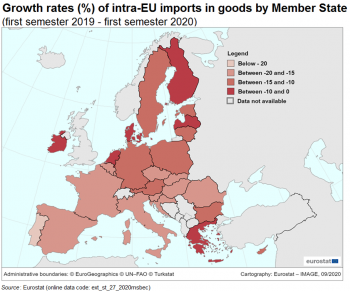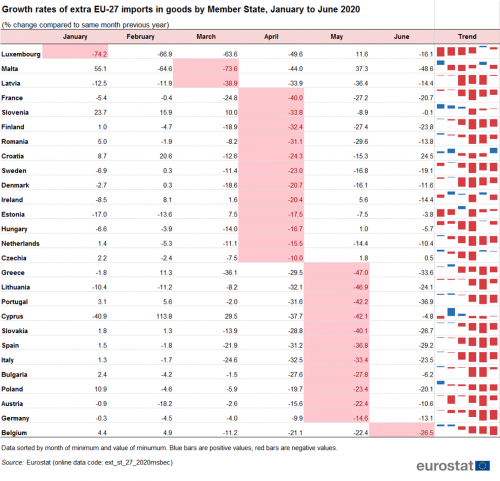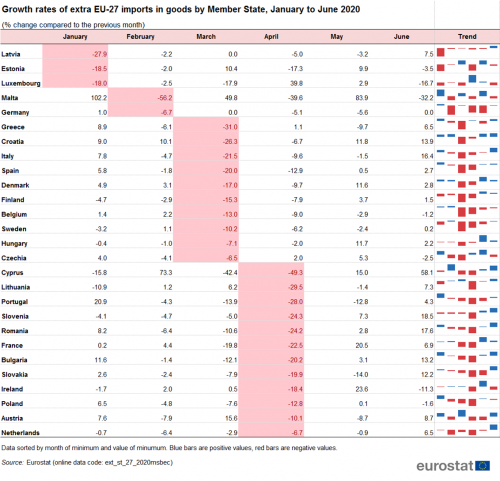Archive:Impact of COVID-19 on international trade by Member State
Data extracted in August 2020.
No planned update.
Highlights
For EU Imports and exports of goods, April and May 2020 were the months most affected by the COVID-19 crisis, compared with 2019.
EU imports and exports of goods in July increased compared with the previous month.
To help prevent the spread of the COVID-19 pandemic, countries around the world have taken a variety of restrictive measures, which have negatively affected international trade in goods. This article is part of an online publication containing articles on the Impact of COVID-19 on international trade in goods statistics. In this article, the impact by Member State is presented. To ensure comparability over time seasonally and working-day adjusted data are used.
Full article
Comparison with the previous year
Figure 1 shows the decline inextra-EU-27 trade due to restrictive measures taken relating to the COVID-19 virus. The drop in exports between February and April 2020 was larger than the drop in imports, leading to a trade deficit in April 2020. Exports recovered somewhat stronger than imports, creating a surplus in May, June and July 2020. However, neither imports nor exports have reached pre-crisis levels yet.
Maps 1 to 4 show the growth rates of both intra-EU and extra-EU imports and exports, comparing the first semester of 2020 with the first semester of 2019. To allow easy comparison, all maps have the same legend although the above zero category is not needed for the two maps on extra-EU and intra-EU imports.
The drops in extra-EU exports and imports varied across Member States (see Maps 1 and 2). In nine Member States imports fell by less than 10 %. In seven Member States they fell between 10 % and 15 % and in five Member States they fell between 15 % and 20 %. Imports fell most in Luxembourg (- 55 %), Malta (- 43 %), Latvia (- 26%), Greece (- 24 %), Lithuania (- 23 %) and Spain (- 20 %).
For extra-EU exports there were four Member States whose exports grew in the first semester of 2020 compared with the first semester of 2019. These were Cyprus, Slovenia, Ireland and Denmark. The exports of seven Member States fell by less than 10 % and a further seven Member States had decreases between 10 % and 15 %. In six Member States exports decreased between 15 % and 20 %. The largest drops were seen in Greece (- 22 %), France (-24 %) and Luxembourg (- 29 %).

Source: Eurostat (ext_st_27_2020msbec)

Source: Eurostat (ext_st_27_2020msbec)
Drops in intra-EU exports and imports are shown in Maps 3 and 4. In seven Member States imports fell by less than 10 %. In eight Member States they fell between 10 % and 15 % and in eleven Member States they fell between 15 % and 20 %. Imports fell most in Portugal (-21 %). The average drop was 2.7 percentage points smaller for intra-EU imports (-12.7 %) than for extra-EU imports (-15.4 %)
For intra-EU exports, only Ireland (+ 9 %) had an increase. In eight Member States imports fell by less than 10 %. In a further eight Member States they fell between 10 % and 15 % and in six Member States they fell between 15 % and 20 %. Imports fell most in Cyprus (-47 %), Luxembourg (-28 %), Romania (- 24 %) and Malta (- 20 %). The average drop was 4.5 percentage points more for intra-EU exports (-13.9 %) than for extra-EU exports (-9.4 %).

Source: Eurostat (ext_st_27_2020msbec)

Source: Eurostat (ext_st_27_2020msbec)
Comparison with the same month previous year
In 2020, April (for 12 Member States) and May (for 11 Member States) were the two months when extra-EU imports were at a minimum for most Member States, compared with the same months in 2019. The exceptions were Belgium (June), Malta and Latvia (both March) and Luxembourg [1](January). In five countries (Malta, Luxembourg, Ireland, Czechia and Hungary) imports in May 2020 grew compared with May 2019, however, in June this was the case only in Croatia and Czechia.

Source: Eurostat (ext_st_27_2020msbec)
April (for 14 Member States) and May (for 10 Member States) were also the two months where exports fell most in 2020 compared with the same months in 2019. Cyprus, Malta and Slovenia followed in June. In June 2020 exports from Estonia, Slovenia and Poland grew compared with June 2019 while in Croatia and Slovakia they were almost equal to the previous year.

Source: Eurostat (ext_st_27_2020msbec)
Comparison with the previous month
In the month to month comparison of imports, March (for 10 Member States) and April (for 12 Member States) were the months where exports contracted most compared with the previous month. In May 2020, exports from 16 Member States increased, growing to 19 Member States in June 2020.

Source: Eurostat (ext_st_27_2020msbec)
For most Member States exports recovered earlier than imports. In 20 Member States, they reached a minimum in April. In May, exports increased in 17 Member States. This number grew to 21 Member States in June. Slovakia (+ 41 %) had the highest growth rate in June, followed by Croatia (+ 22 %) and Romania (+ 21%). With the exception of Cyprus[2] there were no Member States whose exports fell by more than 10 %.

Source: Eurostat (ext_st_27_2020msbec)
Source data for tables and graphs
Data sources
EU data is taken from Eurostat's COMEXT database. COMEXT is the reference database for international trade in goods. It provides access not only to both recent and historical data from the EU Member States but also to statistics of a significant number of third countries. International trade aggregated and detailed statistics disseminated via the Eurostat website are compiled from COMEXT data according to a monthly process.
Data are collected by the competent national authorities of the Member States and compiled according to a harmonised methodology established by EU regulations before transmission to Eurostat. For extra-EU trade, the statistical information is mainly provided by the traders on the basis of customs declarations.
EU data are compiled according to Community guidelines and may, therefore, differ from national data published by the Member States. Statistics on extra-EU trade are calculated as the sum of trade of each of the 27 EU Member States with countries outside the EU. In other words, the EU is considered as a single trading entity and trade flows are measured into and out of the area, but not within it.
The EU-27 data reflect the political change in the EU composition. Therefore, the United Kingdom is considered as an extra-EU partner country for the EU-27. However, the United Kingdom is still part of the internal market until the end of the transitory period, meaning that data on trade with the United Kingdom are still based on statistical concepts applicable to trade between the EU Member States. As a consequence, while imports from any other extra-EU-27 trade partner are grouped by country of origin, the United Kingdom data reflect country of consignment. In practice this means that the goods imported by the EU-27 from the United Kingdom were physically transported from the United Kingdom but part of these goods could have been of other origin than the United Kingdom. For this reason data on trade with the United Kingdom are not fully comparable with data on trade with other extra-EU-27 trade partners.
Methodology
In this article some products are classified as COVID-19 related products. They are compared over time and across countries, and also with products in the same chapter of the Harmonised System (HS) product classification, i.e. they are compared with other similar products that are however not directly used in response to the COVID-19 pandemic. It should be noted that most COVID-19 related products cannot be precisely identified and they are grouped together with products not specific to COVID-19. Nevertheless, some trends can be observed.
According to the EU concepts and definitions, extra-EU trade statistics (trade between EU Member States and non-EU countries) do not record exchanges involving goods in transit, placed in a customs warehouse or given temporary admission (for trade fairs, temporary exhibitions, tests, etc.). This is known as ‘special trade’. The partner is the country of final destination of the goods for exports and the country of origin for imports.
Unit of measure
Trade values are expressed in millions or billions (109) of euros. They correspond to the statistical value, i.e. to the amount which would be invoiced in the event of sale or purchase at the national border of the reporting country. It is called a FOB value (free on board) for exports and a CIF value (cost, insurance, freight) for imports.
Context
Trade is an important indicator of Europe’s prosperity and place in the world. The bloc is deeply integrated into global markets both for the products it sources and the exports it sells. The EU trade policy is an important element of the external dimension of the ‘Europe 2020 strategy for smart, sustainable and inclusive growth’ and is one of the main pillars of the EU’s relations with the rest of the world.
Because the 27 EU Member States share a single market and a single external border, they also have a single trade policy. EU Member States speak and negotiate collectively, both in the World Trade Organization, where the rules of international trade are agreed and enforced, and with individual trading partners. This common policy enables them to speak with one voice in trade negotiations, maximising their impact in such negotiations. This is even more important in a globalised world in which economies tend to cluster together in regional groups.
The openness of the EU’s trade regime has meant that the EU is the biggest player on the global trading scene and remains a good region to do business with. Thanks to the ease of modern transport and communications, it is now easier to produce, buy and sell goods around the world which gives European companies of every size the potential to trade outside Europe.
Direct access to
- International trade in goods (t_ext_go), see:
- International trade in goods - long-term indicators (t_ext_go_lti)
- International trade in goods - short-term indicators (t_ext_go_sti)
- International trade in goods (ext_go), see:
- International trade in goods - aggregated data (ext_go_agg)
- International trade in goods - long-term indicators (ext_go_lti)
- International trade in goods - short-term indicators (ext_go_sti)
- International trade in goods - detailed data (detail)
- EU trade since 1988 by SITC (DS-018995)
- International trade in goods statistics - background
- International trade in goods (ESMS metadata file — ext_go_esms)
- User guide on European statistics on international trade in goods
Notes
- ↑ The low values for Luxembourg from January to April were mainly due to unusually large transit trade in the beginning of 2019 and only partly related to the COVID-19 crisis.
- ↑ The dramatic reduction in exports from Cyprus between May and June 2020 was due to a sharp reduction in exports of ships and boats.
